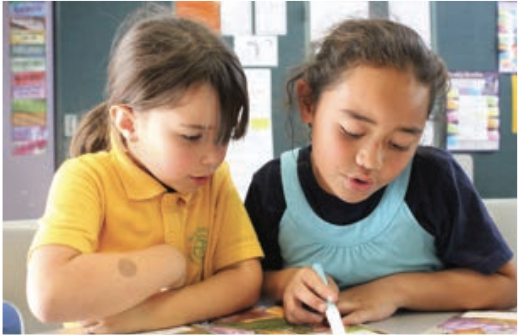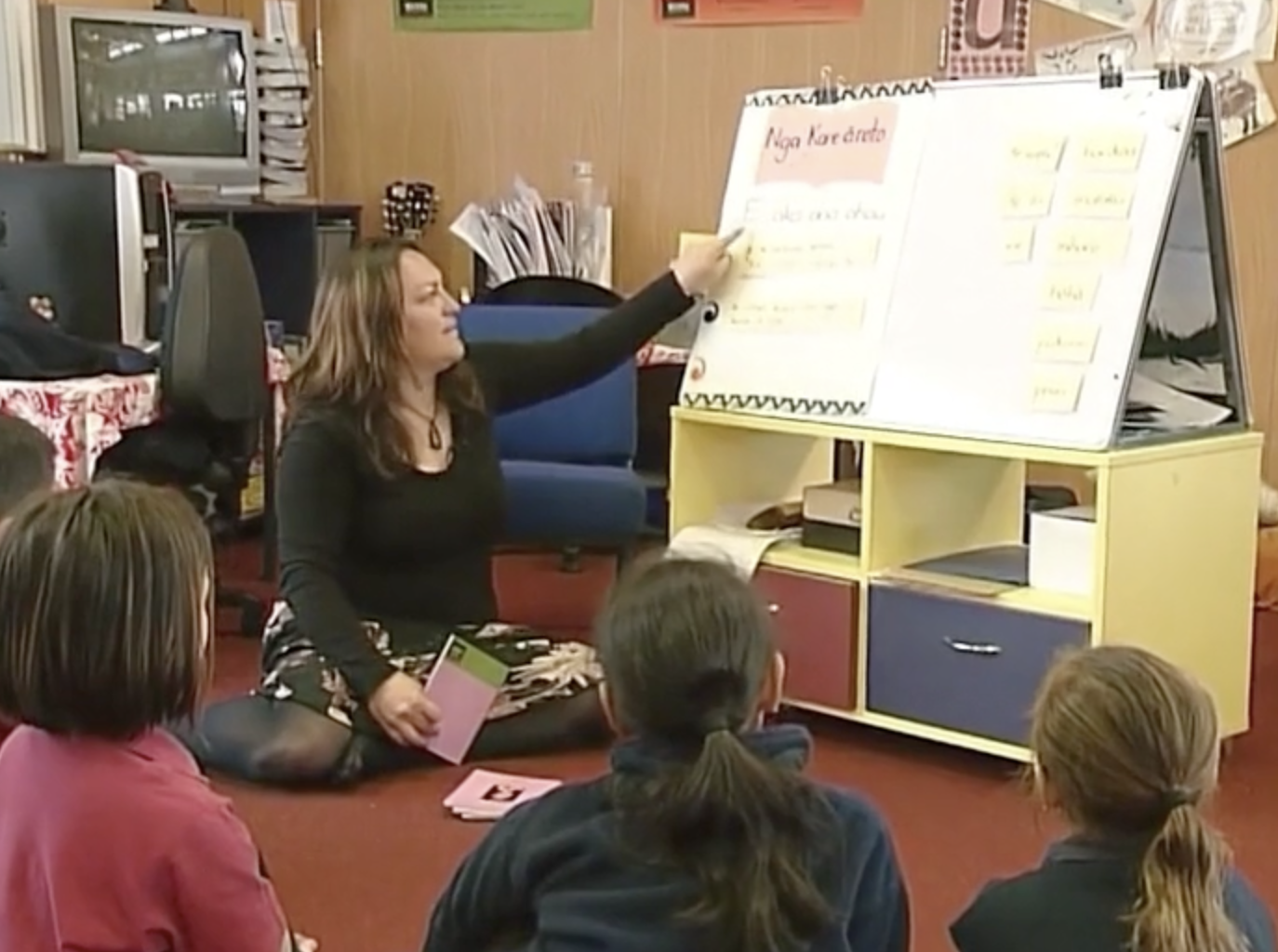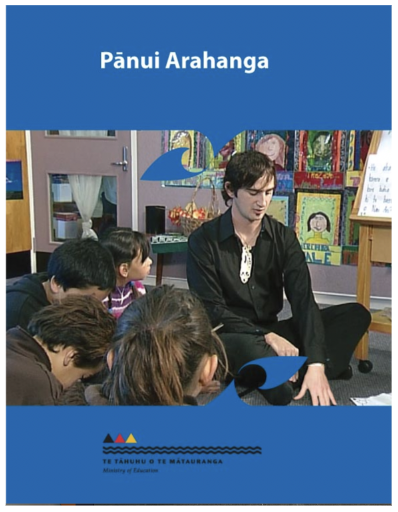I TE TAU TUATORU
TE ARA WHAKAAKO I TE PĀNUI
Whārangi Ihirangi
Mātua ko te Kōtuitui
Kaiako should explicitly plan to integrate the language strands, whakarongo, kōrero, pānui, tuhituhi, mātakitaki and whakaatu.
Language competency is critical for ākonga to successfully access the curriculum and learning that is relevant to their world.
It is important to make connections across the curriculum between prior knowledge and new knowledge by providing a range of stimulating and engaging experiences.
I te tau tuatoru: Te Ara Whakaako i te Pānui
Te whakamāramatanga me ngā āhuatanga
PĀNUI NGĀTAHI | SHARED READING
Pānui Ngātahi is a collaborative instructional reading approach where a kaiako and a group of mokopuna read a text together. Typically, the kaiako reads aloud modelling reading behaviours, while ākonga read along. The focus is on shared interaction between the kaiako and ākonga where connections to prior knowledge are made and where skills and strategies can be introduced and revised.
Te whakamāramatanga me ngā āhuatanga
PĀNUI MOTUHAKE | INDEPENDENT READING
Pānui Motuhake enables ākonga to read independently for enjoyment and to practise their developing pānui skills. As a rule of thumb, Ngā Kete Kōrero texts at levels lower than the level they are working on instructionally are a good source of texts for this purpose.
Te whakamāramatanga me ngā āhuatanga
PĀNUI ARAHANGA | GUIDED READING
Pānui Arahanga is an approach where a kaiako works with a small group of ākonga who are at a similar reading level or have similar instructional needs. The focus is on the kaiako providing support and guidance as ākonga read books at their instructional level to learn, practice and apply decoding, comprehension strategies and critical thinking skills. The goal is to tailor instruction to the needs of the group, and individuals within the group.
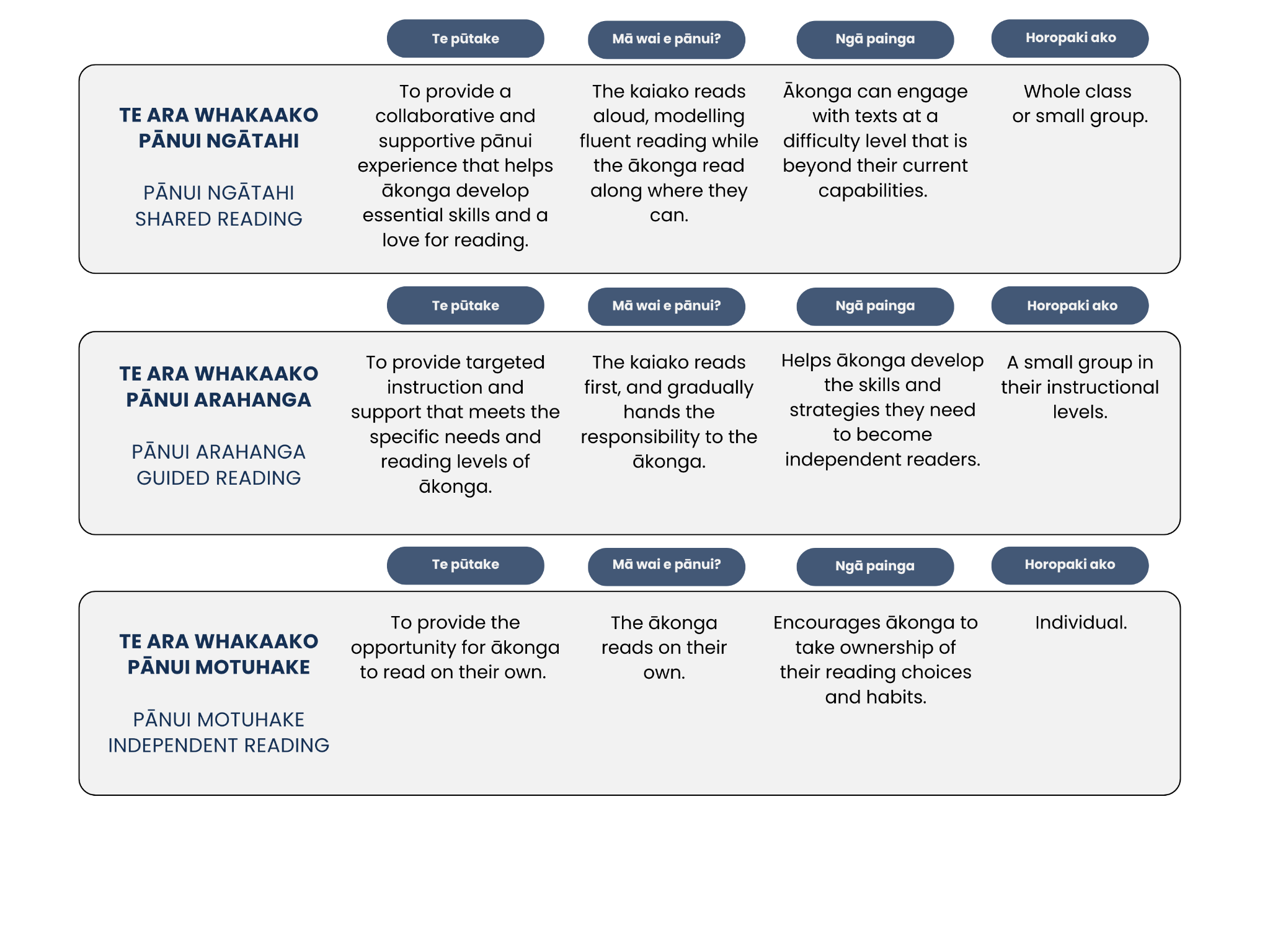
I te tau tuatoru: Te Whakahaere i te Pānui Ngātahi
In the first three years at kura, ākonga should be reading a range of texts to consolidate the decoding and comprehension skills they have acquired and accumulated so far.
Kaiako in the year three class should be fully conversant with what ākonga in the preceding year at kura have learnt. This can be achieved by carefully studying the content detailed for the second year at kura, and checking in with the ākonga themselves as well as their previous kaiako as appropriate.
Kaiako in the year three class should also acquaint themselves fully with the learning for year four so they can prepare ākonga for the learning at that next stage.
The year three 'consolidation phase' is an important transition point - most ākonga in the first three years will be between mastering basic pānui skills related to 'learning to read' and 'using reading as a tool for acquiring new information and knowledge, i.e. 'reading to learn'.
Ngā Kete Kōrero levels Kiekie to early Pīngao are useful for supporting ākonga who are still learning to read while reading to learn is associated with Ngā Kete Kōrero level mid-Pīngao.
Kura: Nawton School
Kaiako: Lisa Hopa
Taumata: Tau 0–1
He akoranga Pānui Ngātahi tēnei e aro atu ana ki ngā tikanga tuhituhi me te hanganga o te pukapuka.
NOTE: The video example is indicative only - you will need to adapt the content to ensure it is appropriate for ākonga in their third year at kura.
Ngā pukapuka hei kawe i te pānui ngātahi
Texts that are more difficult than the pānui instructional level of the ākonga can be used as material to read to them (so they can still access the information and language) or used for pānui ngātahi.
Ngā Kete Kōrero series has a broad selection of texts for these purposes.
For pānui ngātahi, think about making texts selections based on
a kaupapa (this can be linked to other wāhanga ako)
language structures and vocabulary items (e.g. kupuhono).
literary features (e.g. kupu whakarite - simile)
text type or purpose (e.g. he tuhinga taki - recount)
an author and/or illustrator.
Transcript
[Pouako ki ngā mokopuna]
Anei tō tātou whāinga i tēnei ata. Titiro. E ako ana mātou i ngā tikanga o te tuhituhi, arā, te uwhi o mua, te uwhi o muri, te tapanga, te taitara rānei, te tuara o te pukapuka. Kei te pai tērā?
Āe. [mokopuna]
[Pouako]
Ki ahau nei, he pai ngā mea … ngā pukapuka rahi. Kia māmā te kite mō ngā tamariki, te kite i te āhuatanga o te tuhituhi, ā… te ātaahua hoki o ngā pikitia. Me te mea nei, ā, ngā pukapuka ngākaunui ki a rātou.
[Pouako me ngā mokopuna]
Kua rite tātou ki te pānui tēnei pukapuka?
Kāo. Huri te pukapuka.
Nē, me huri a Whaea Lisa i te pukapuka?
Āe.
Haere anō.
Kua rite a Whaea Lisa ki te pānui te pukapuka i tēnei wā?
Kāo.
He aha Charlie? He aha te raru?
[Pouako]
Mō ngā pīpī paopao, ko te whāinga ki a au ngā momo āhuatanga o te pukapuka. Te uwhi o mua, te uwhi o muri.
[Pouako me ngā mokopuna]
Me tīmata anō a Whaea Lisa? Āe. Me huri te pukapuka? Āe!
Ara! Kua tīmata a Whaea Lisa ki te...
Huri anō!
Nē, i huri a Whaea Lisa i te pukapuka.
...pēnei. ...tēnei
Kāo.
Me huri anō?
Āe.
[Pouako]
Ka āta titiro ki ngā ira kati, ngā tohu kōrero pērā i te ira kati, ki ngā tohu pātai, ērā momo. Ka tīmata tātou ki whea? … ērā momo āhuatanga e pā ana ki te pānui.
[Pouako me ngā mokopuna]
Pēhea koe ka mōhio ko tērā te tapanga?
Nō te mea i tīmata i te …. ‘t’.
I te ‘t’? Āe. He tohu anō kia mōhio ai koe he tapanga tēnei?
Kāo.
Te āhua nei he tino n … nui. Tino nui te tuhituhi, nē rā.
Āe.
Te Taniwha me te Poraka.
Me tīmata a Whaea Lisa ki te pānui i whea? Tū mai tō ringa mehemea ka mōhio, tohu atu. Tohua, ka tīmata a Whaea Lisa ki te pānui ki whea?
[Pouako]
I tēnei wā ka ū tonu ahau ki te pukapuka, engari, ka mōhio au ka aro ētahi ki te rotarota, ngā waiata … Mehemea e hāngai ana ērā, ngā waiata ki te kaupapa matua, he kaha mātou ki te … ki te āta titiro ki ngā …ki ngā waiata e hāngai ana ki tō tātou rohe, ērā momo. Ka āta titiro ki ngā kupu kaumātua pea ka puta mai i roto i ngā pepeha, ngā whakataukī.
[Pouako me ngā mokopuna]
Nā wai i kī “uaka!”?
Ko te poraka.
Nē. Titiro ki te āhua o te taniwha. Kei te pōuri ia? Te taniwha? Nē? Kei te mataku ia i te aha?
Te poraka.
Nē … Kia tūpato Taniwha. Kei muri te poraka i a koe. Kia tere te kauhoe atu! Ka pai.
[Pouako]
He maha ngā mahi mō te kaiako hei whakarite mō te pānui tahi. Te nuinga o te wā ka whakaritehia he rauemi. Mehemea e hiahia ana kia ātaahua ngā rauemi, ka kapi mā te pukapuka ka whakapiri ki tētahi kāri kia pai ake. Kia taea e ngā tamariki te mahi anō i roto i ō rātou ake wā.
[Pouako me ngā mokopuna]
E tū harakeke. Kua rite tātou? Kei te mau tō kanohi poraka? Āe. Kia tūpato Poraka kei muri te taniwha i te harakeke. E peke, kia tere!
[Pouako]
E kaha ana ahau ki te kimi i te pukapuka e ngākaunui ana ki ngā tamariki. Mehemea he ngākaunui te pukapuka ki a rātou he māmā noa iho ki (mā)a rātou te whakautu pātai ki a koe. He maha ngā pukapuka pērā, i nāianei i te kura. Ki taku nei titiro, he tino pai ki a rātou ngā tamariki ki te rāwekeweke i ngā rauemi kia kore ai e maroke te mahi … kia kore e tuhituhi anake te mahi … ka taea e rātou te raweke hoki i ngā mahi hei āwhina i a rātou ki te oti pai i te whāinga o te mahi. Ki ahau nei he tino pai ngā (te) mahi whakaari ki a rātou, ngā tamariki. He tino whetū amorangi rātou.
[Hamahama waiata]
I te tau tuatoru: Te Whakahaere i te Pānui Arahanga
Kura: Te Kura Kaupapa Māori o Hoani Waititi
Kaiako: Linda Rudolph
Taumata: Tau 1
Tuhinga: Ngā Kare ā Roto
Taumata whakaako: Harakeke E (KHe)
He akoranga tēnei e whakaatū ana i te Pānui Arahanga.
I tēnei tauira ka mātakihia te roanga o te akoranga, arā te whakahaerenga mai i te tīmatanga ki te mutunga.
Ko Linda Rudolph o Te Kura Kaupapa Māori o Hoani Waititi Marae e whakaako ana i te tauira tuatahi.
NOTE: The video example is indicative only - you will need to adapt the content to ensure it is appropriate for ākonga in their third year of kura.
This is the second day that Linda is using pānui arahanga approach with these ākonga using the text Ngā Kare ā Roto.
Ngā pukapuka hei kawe i te pānui arahanga
When ākonga are building words to read and write through the explicit instruction described in Rangaranga Reo ā-Ta: Ngā Kūoro me te Tautohu Kupu (akoranga ) they can engage with Ngā Kete Kōrero texts through Pānui Arahanga.
Start with texts at Harakeke to get a sense of ākonga readiness. While they may be able to decode the words, also check they are drawing on their own experiences to make connections with the text, they are using clues in the illustrations, and applying their developing knowledge of language structure to understand what they are reading. If these texts are not challenging enough, the Harakeke level books can become independent reading material and you can look to the next level, Kiekie, for sources of instructional reading material.

Interview with the Kaiako
Pātai ki a Linda: Why have you got two sets of whāinga on your plan?
Tana whakautu: One set is what I want the ākonga to be explicitly aware of. These are the ones that I want them to articulate and hopefully self-monitor. These also relate specifically to this text. The other set are whāinga that I know generalize across texts at the harakeke level. I am also using these informally to assess the progress and achievement of these ākonga.
Pātai ki a Linda: Why did you approach this text in this particular way?
Tana whakautu: The indications are that these ākonga are ready for a higher more challenging level so I wanted to check the consistency of their directional skills. Most of them already know their letters and sounds so I also wanted to see how they use this knowledge to predict or confirm their attempts at words.
Many of these texts have Teacher Support Materials which are searchable on Tāhūrangi.
Think about selecting texts and creating units of work based on:
a kaupapa (this can be linked to other wāhanga ako)
language structure
literary features
text type or purpose
an author and/or illustrator.
As a general rule of thumb, use material at lower instructional levels for independent reading (pānui motuhake), and texts that are more difficult than their instructional level as material to read to them (so they can still access the information and language) or used for pānui ngātahi.
Hei tīmatanga | Getting started
Te tiro ki te whakataki me te tiro anō ki te tuhinga | Previewing and reviewing text
Te whakapūrangiaho i ngā akoranga ki ngā ākonga | Articulating the learning to ākonga
4. Te aronga ki te mahi hei whakaako | Focussing in on instruction: Features of the text
Te āta whakamahi i ngā kupu ārahi me ngā pātai | Making effective use of prompts and questions
1. Te whakaharatau rautaki pānui | Practising reading strategies
7. Te whakaharatau rautaki pānui | Practising reading strategies: Integrating strategies on text
Te whakaū | Following on: Follow-up activities
Te whakaū | Following on: Reflecting on your lesson
Tauira 1 | Tau 1 (Ngā Kare ā Roto) Mahere Ako
I te tau tuatoru: Ngā Toi Mokopuna - Pānui
This section outlines the skills, strategies and knowledge required in pānui in the first three years.
I ngā marama e ono
I te tau tuatahi
I ngā marama tekau mā waru ki te tau tuatoru
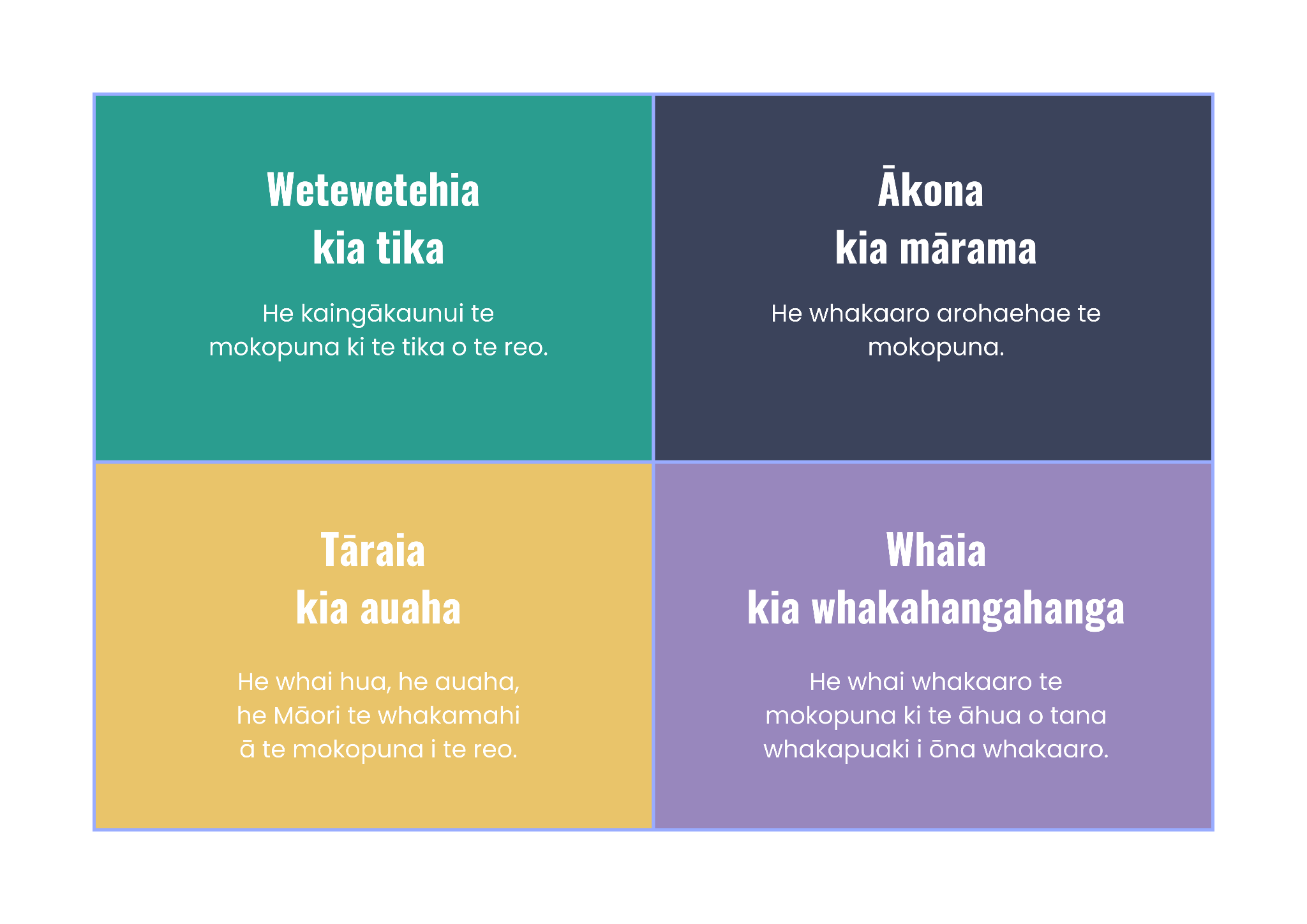

Wetewetehia kia tika
He kaingākaunui te mokopuna ki te tika o te reo.
Te whāinga
Ākonga learning focuses on accurately using and understanding basic vocabulary and sentence structures.
Ngā Tohu Ako
Te ngako o te whāinga
During a pānui lesson, support ākonga to:
Read an increasing number of high frequency words automatically.
Differentiate between classes of words e.g., tūmahi and tūāhua.
Use simple punctuation (e.g., commas, question marks, speech marks and exclamation marks) and explain their function.
Correct some errors in pānui.
Identify and use simple conjunctions accurately.
Follow simple grammatical rules.
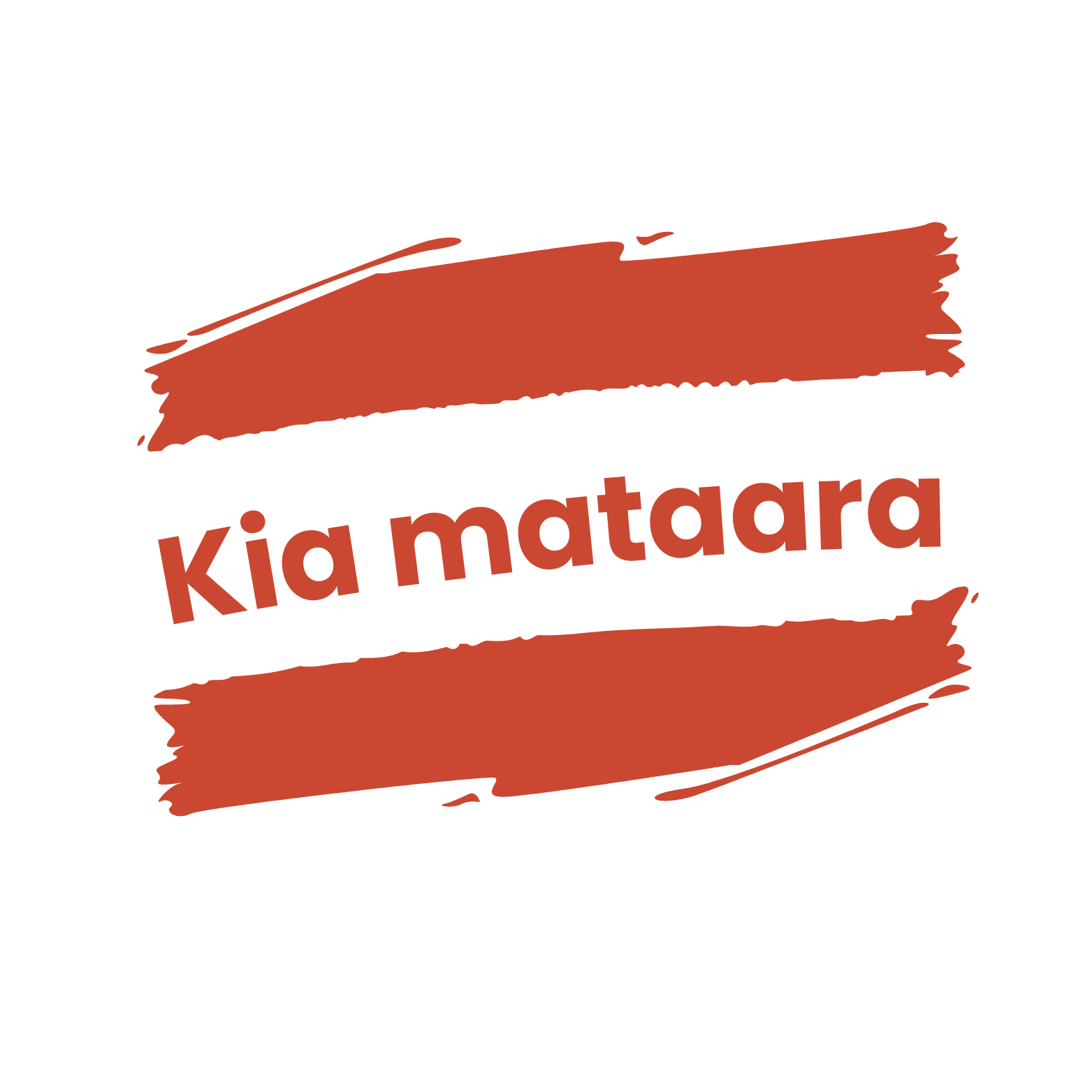
By the end of 3 years at kura, ākonga should be:
speaking in full sentences.
correcting some errors in pānui and tuhituhi because they know the word they used doesn’t match the word in the text or make sense in context.
attempting to correct spelling of high frequency words when they are told an error has been made.
Ākona kia mārama
He whakaaro arohaehae te mokopuna.
Te whāinga
Ākonga learning focuses on accurately using and understanding basic vocabulary and sentence structures.
Ngā Tohu Ako
Te ngako o te whāinga
During a pānui lesson, support ākonga to:
Use basic strategies (e.g., prediction, scanning, imaging, summarising, inference).
Identify main ideas and key information and link these to their own experiences.
Use strategies to regain meaning when that meaning is lost.
Talk about the cues and strategies they use to check and clarify meaning.
Formulate questions arising from the reading that broaden thoughts and ideas.
Whāia kia whakahangahanga
He whai whakaaro te mokopuna ki te āhua o tana whakapuaki i ōna whakaaro.
Te whāinga
Ākonga learning focuses on developing basic interpersonal communication skills.
Ngā Tohu Ako
Te ngako o te whāinga
During a pānui lesson, support the ākonga to:
Share personal responses about a text.
Tāraia kia auaha
He whai hua, he auaha, he Māori te whakamahi a te mokopuna i te reo.
Te whāinga
Ākonga learning focuses on discovering ways to express thoughts and imagination.
Ngā Tohu Ako
Te ngako o te whāinga
During a pānui lesson, support ākonga to:
Retell and act out stories they have read.
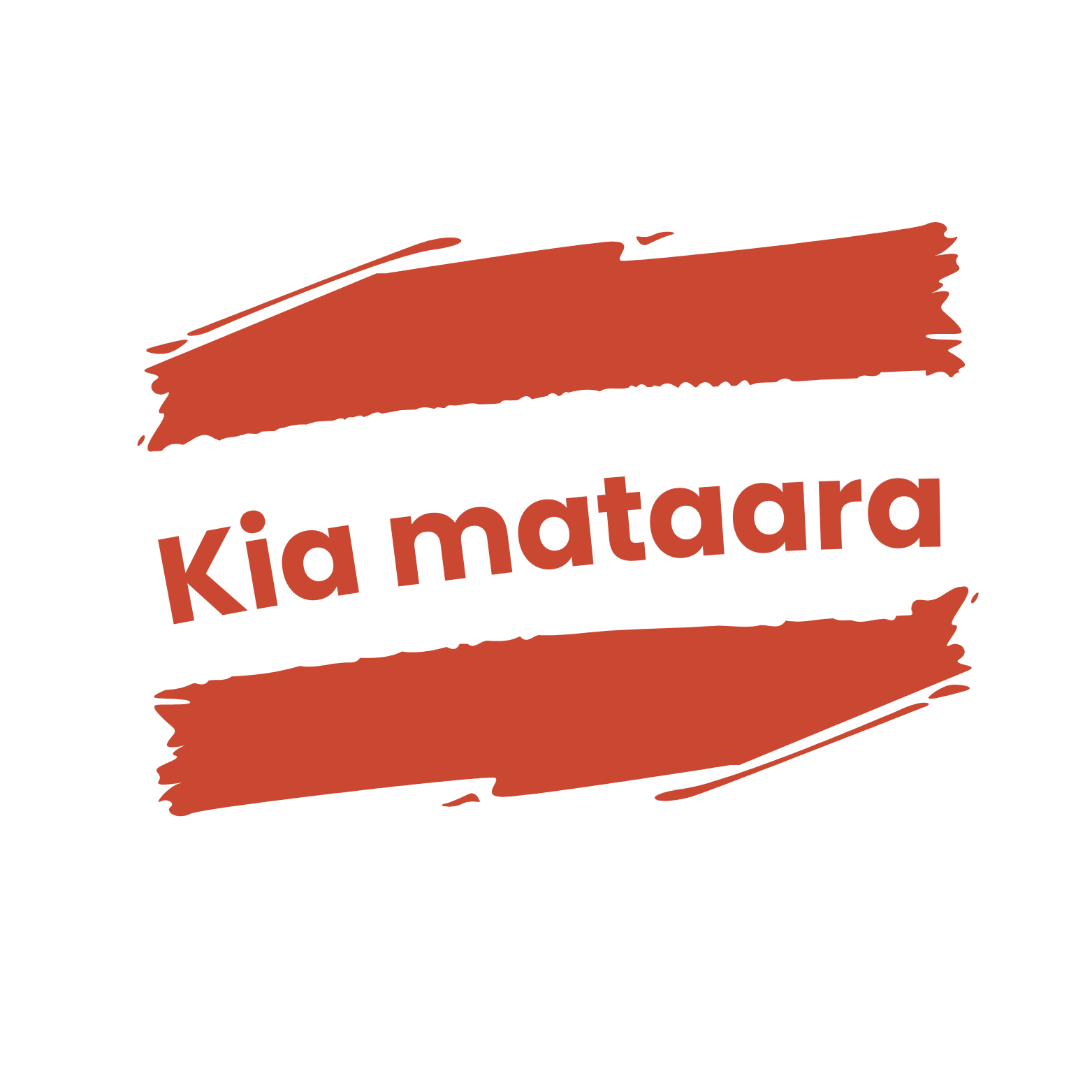
By the end of three years at kura, ākonga should be able to:
tell a simple story.
recount an experience.
retell a local story.
I te tau tuatoru: Te Aromatawai i te Pānui
Aromatawai ō te ako (of learning), and aromatawai mō te ako (for learning).
Aromatawai should be personalised to reflect the reality that ākonga are at different stages in their learning journey and move through that journey at different speeds. This includes valuing neurodiversity (i.e. that all brains function differently) which is particularly important for neurodivergent ākonga.
Ākonga should be encouraged and supported to understand the purpose of aromatawai and be active participants in gathering information through aromatawai activities such as self-reflection, self assessment and the creation of portfolios of work that demonstrate their learning.
Source: Te Puāwaitanga Harakeke p. 17
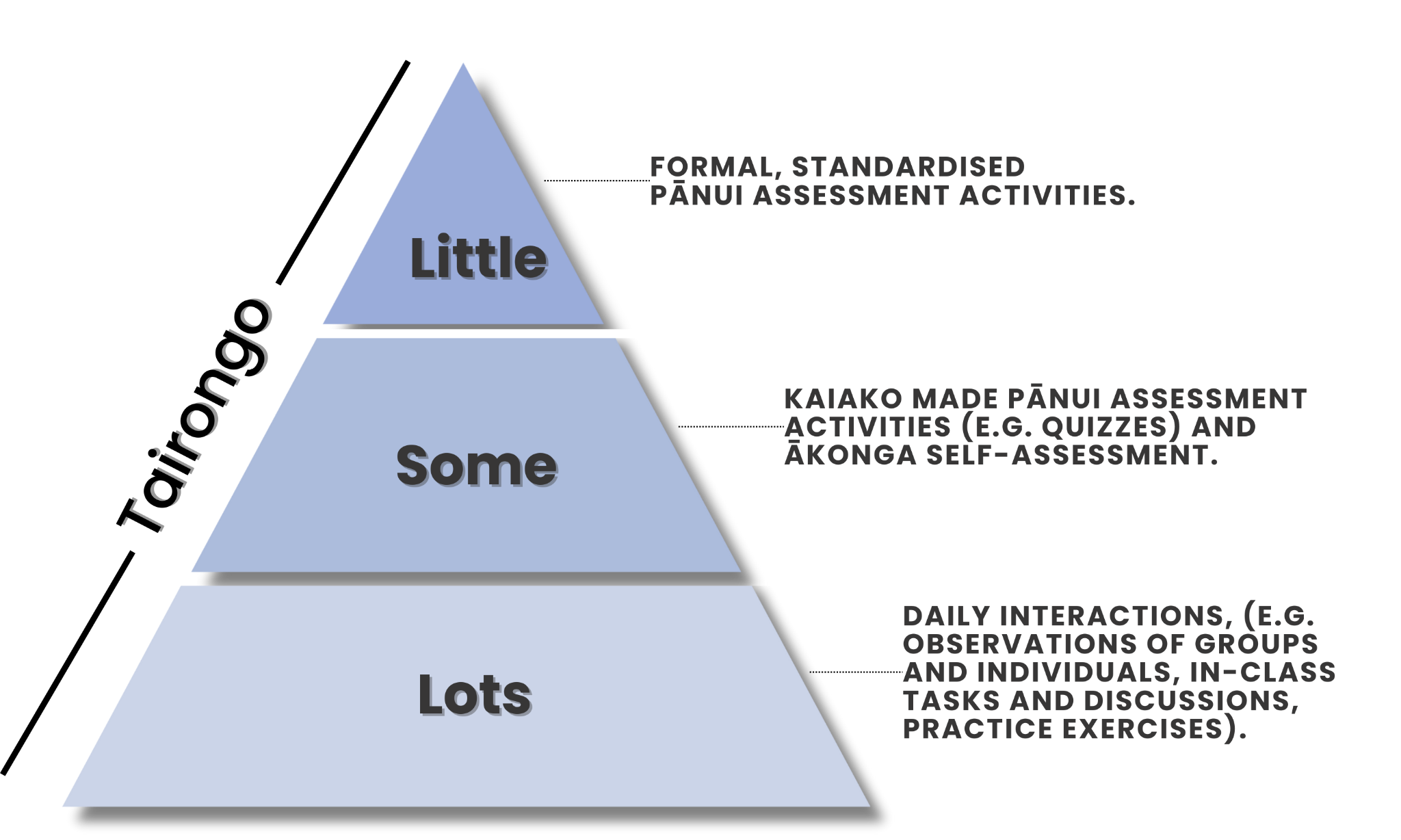
MAHI AROMATAWAI: What to look/listen for, ākonga are:
Choosing to re-read texts used in pānui ngātahi and pānui arahanga independently.
Applying their decoding skills on texts they are reading independently.
Using words, phrases and sentences from a text used in pānui ngātahi and/or pānui arahanga in their writing and oral language.
Consistently and accurately matching the spoken word to the written word.
Assessment tasks: currently being trialled
Te Mōhiohio Pū (Phonics check),
Te Mōhiohio Kupu,
Te Mōhiohio Orotuhi at 55 weeks (in draft)
I te tau tuarua: He Huarahi Pānui Anō
Pānui ki | Reading to:
Involves a kaiako or more skilled reader reading aloud to ākonga.
The focus is on reading in ways that engage ākonga and foster the love of reading. Ākonga experience expressive and fluent reading as they listen.
Pānui tautokotahi | Reading with:
Involves the kaiako reading at the same time as ākonga during scheduled 'silent reading' times.
The focus is on modelling the value of reading and reading for enjoyment.
Pānui motuhake | Independent reading:
Refers to ākonga reading, viewing and comprehending and enjoying texts on their own.
The focus is on fostering a love of reading. The reader also has the opportunity to practice their knowledge, skills and strategies without direct support from the kaiako.
